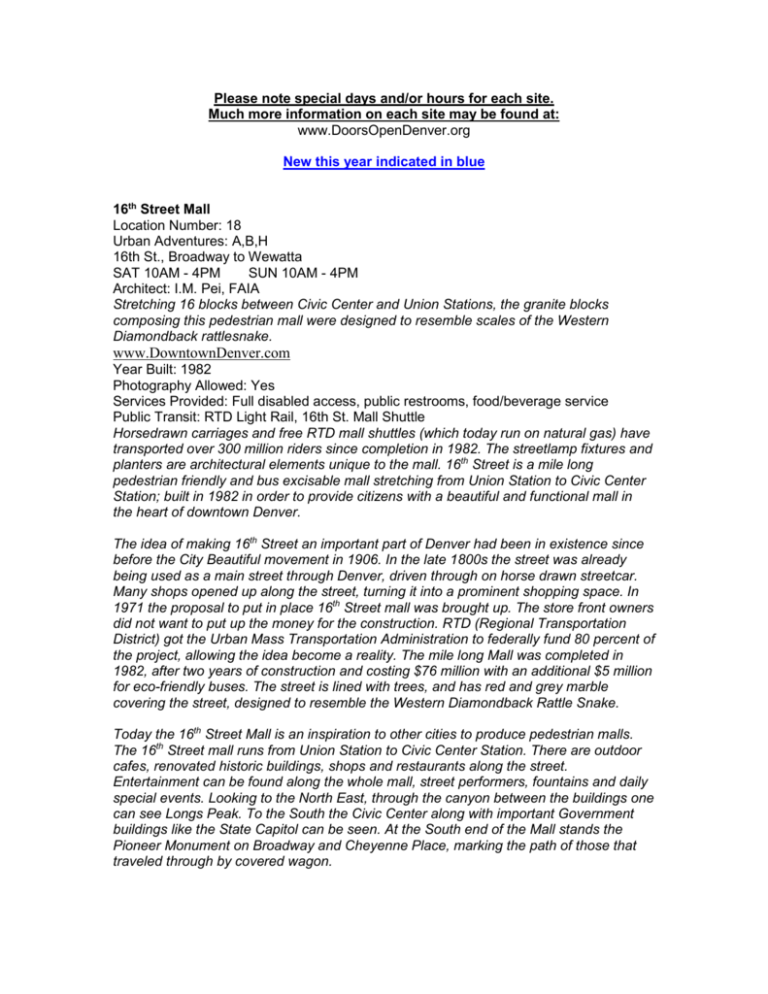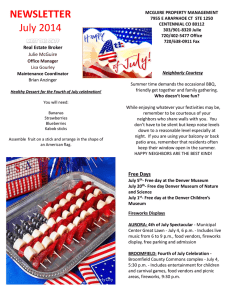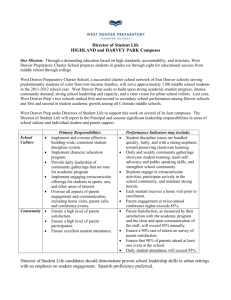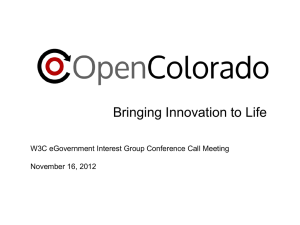Please note special days and/or hours for each site. Much more
advertisement

Please note special days and/or hours for each site. Much more information on each site may be found at: www.DoorsOpenDenver.org New this year indicated in blue 16th Street Mall Location Number: 18 Urban Adventures: A,B,H 16th St., Broadway to Wewatta SAT 10AM - 4PM SUN 10AM - 4PM Architect: I.M. Pei, FAIA Stretching 16 blocks between Civic Center and Union Stations, the granite blocks composing this pedestrian mall were designed to resemble scales of the Western Diamondback rattlesnake. www.DowntownDenver.com Year Built: 1982 Photography Allowed: Yes Services Provided: Full disabled access, public restrooms, food/beverage service Public Transit: RTD Light Rail, 16th St. Mall Shuttle Horsedrawn carriages and free RTD mall shuttles (which today run on natural gas) have transported over 300 million riders since completion in 1982. The streetlamp fixtures and planters are architectural elements unique to the mall. 16th Street is a mile long pedestrian friendly and bus excisable mall stretching from Union Station to Civic Center Station; built in 1982 in order to provide citizens with a beautiful and functional mall in the heart of downtown Denver. The idea of making 16th Street an important part of Denver had been in existence since before the City Beautiful movement in 1906. In the late 1800s the street was already being used as a main street through Denver, driven through on horse drawn streetcar. Many shops opened up along the street, turning it into a prominent shopping space. In 1971 the proposal to put in place 16th Street mall was brought up. The store front owners did not want to put up the money for the construction. RTD (Regional Transportation District) got the Urban Mass Transportation Administration to federally fund 80 percent of the project, allowing the idea become a reality. The mile long Mall was completed in 1982, after two years of construction and costing $76 million with an additional $5 million for eco-friendly buses. The street is lined with trees, and has red and grey marble covering the street, designed to resemble the Western Diamondback Rattle Snake. Today the 16th Street Mall is an inspiration to other cities to produce pedestrian malls. The 16th Street mall runs from Union Station to Civic Center Station. There are outdoor cafes, renovated historic buildings, shops and restaurants along the street. Entertainment can be found along the whole mall, street performers, fountains and daily special events. Looking to the North East, through the canyon between the buildings one can see Longs Peak. To the South the Civic Center along with important Government buildings like the State Capitol can be seen. At the South end of the Mall stands the Pioneer Monument on Broadway and Cheyenne Place, marking the path of those that traveled through by covered wagon. Byers-Evans House Museum Location Number: 44 Urban Adventures: G, J 1310 Bannock St. SAT 10AM - 4PM SUN 10AM - 4PM Architect: Unknown The Byers-Evans House Museum, a Denver landmark, was built by the first publisher of the Rocky Mountain News. www.ByersEvansHouseMuseum.org Year Built: 1883 Photography Allowed: No flash photography allowed Services Provided: Partial disabled access; food/beverage services; paid parking The museum was sold in 1889 to William Evans, an officer of the Denver Tramway Company and the son of Colorado’s second territorial governor, John Evans. The home is interpreted to the period of 1912–24 with furnishings original to the Evans family. Guides will give visitors a glimpse of the museum’s first floor. The Byers-Evans House Museum at 1310 Bannock Street was home to two prominent families in Denver’s past. The home was built in 1883 by William N. Byers, founding editor of the Rocky Mountain News. Although the architect is unknown, this middle class home was built in the Italianate style of architecture, featuring wide eaves and a flat pitched roof. In 1889, the home was sold to William G. Evans, President of the Denver Tramway Company and the son of Colorado’s second Territorial Governor. The Evans family made five additions to the home prior to 1912, almost doubling the size of the original structure. The home remained in the Evans family for nearly 90 years and was given to History Colorado in 1981 along with its contents. A Denver landmark, the Byers-Evans House has been beautifully restored to the period between 1912 and 1924. Polished wood finishes, brightly patterned wallpapers, ornate mantels, and period draperies form a backdrop for the rich variety of Evans family furnishings. The Byers-Evans House Museum is listed on the National Register of Historic Places (1970) and has been designated a Denver Landmark (Number 5, 1963). The Byers-Evans House Museum, a Denver landmark, was built to be a home for the first publisher of the Rocky Mountain News in 1883, but has since been transformed into a public learning center. Although the Byers-Evans House Museum was built before City Beautiful was put in place in 1900, its modern use as a public educational building fits the ideals of the project. The location on 13th Street is also important to City Beautiful because it sits just on the fringes of Civic Center Park, the biggest project Mayor Speers pushed during the City Beautiful movement. The Byers-Evans House Museum at 1310 Bannock Street was home to two prominent families in Denver’s past. The home was built in 1883 by William N. Byers, founding editor of the Rocky Mountain News. Although the architect is unknown, this middle class home was built in the Italianate style of architecture, featuring wide eaves and a flat pitched roof. The elegant design of the home was to show the wealth and power Byers had in the community. In 1889, the home was sold to William G. Evans, President of the Denver Tramway Company and the son of Colorado’s second Territorial Governor, John Evans whom was a close friend to William N. Byers. The Evans family made five additions to the home prior to 1912, almost doubling the size of the original structure. The home remained in the Evans family for nearly 90 years and was given to History Colorado in 1981 along with its contents. A Denver landmark, the Byers-Evans House has been beautifully restored to the period between 1912 and 1924. Polished wood finishes, brightly patterned wallpapers, ornate mantels, and period draperies form a backdrop for the rich variety of Evans family furnishings. The Byers-Evans House Museum is listed on the National Register of Historic Places (1970) and has been designated a Denver Landmark (Number 5, 1963). Byron R. White U.S. Courthouse Location Number: 15 Urban Adventures: G 1823 Stout St. SAT 10AM - 2PM SUN 10AM - 2PM Architect: Tracy, Swartwout & Litchfield Renamed in 1994 for Ft. Collins native, CU All-American and valedictorian, Rhodes scholar, NFL player and Kennedy-appointed Supreme Court Associate Justice Byron “Whizzer” White, this Neoclassical marble federal courthouse was built with a Renaissance Revival interior featuring massive skylights. www.gsa.gov Year Built: 1916 Photography Allowed: No cameras or camera phones are permitted Services Provided: Full disabled access; public restrooms Designed as the main Denver post office, the building was remodeled in 1983 and 1994 to become the current courthouse. Although a 1994 renovation covered the skylights, the building is brightened by exposure to the interior courtyard and recreations of the original cast bronze sconces. The same architects were hired to design the U.S. Post Office and Federal Courthouse. The courthouse occupies an entire city block and stands four stories in height, set above the street in its rusticated base. There are a series of grand stairs that lead to the main entrance and are marked by 16 three-story ionic columns adorned with eagles. On the frieze above the main entrance is inscribed the cities to the east and west of the building, symbolizing the flow of mail across the country. Inscribed on either side of the colonnade are the names of the U.S. Postmaster Generals. The main entry lobby spans the width of the building, with a terrazzo floor and vaulted ceilings. The notable artwork includes a pair of Rocky Mountain sheep and inscribed on wall piers are the Pony Express riders’ names, including Buffalo Bill Cody, an important part of the history of the postal service in the American West. The U.S. General Services Administration (GSA) invites you to celebrate Denver’s unique architectural landscape by participating in Doors Open Denver 2012. Take a step back in time and visit a building that served as a model for other local building projects and its influence can still be seen in other governmental and public structures throughout downtown Denver. The Byron White U. S. Courthouse is located on 1823 Stout Street and it will be open for self-guided tours on April 14-15, from 10 am – 2 pm both days. One of Denver’s first permanent post office and courthouse, the Byron White U.S. Courthouse reveals interesting clues that tell a long and rich Colorado history. You’ll find things like inscribed names on marble-faced walls with names like Buffalo Bill Cody, one of the best-known Pony Express riders, an important part of the history of the postal service in the American West. You can also satisfy the artist in you with a display of four murals by artist Herman T. Schaldermundt, completed in 1918 which were recently restored through GSA’s Fine Arts Program. Details will be available upon entering the building at a self-help station. GSA’s Fine Arts Collection is one of our nation’s oldest and largest public art collections. It consists of permanently installed and moveable mural paintings, sculpture, architectural or environmental works of art, and works on paper dating from 1850 to the present. These civic works of art are in federal buildings and courthouses across the United States. Maintained by GSA as a part of our national and cultural heritage, the Fine Arts Collection serves as a reminder of the important tradition of individual creative expression. Throughout history architectural works are often perceived as cultural and political symbols as well as works of art. Find one of Denver’s hidden historical treasures by participating in Doors Open Denver 2012. This neoclassical marble federal courthouse was built in 1916 with the original purpose of a post office, has a Renaissance Revival interior featuring massive skylights and multiple other works of art in and on the building reflecting the past. Take a step back in time and visit a building that served as a model for other local building projects and its influence can still be seen in other governmental and public structures throughout downtown Denver. The Byron White U. S. Courthouse is located on 1823 Stout Street. One of Denver’s first permanent post office and courthouse, the Byron White U.S. Courthouse reveals interesting clues that tell a long and rich Colorado history. You’ll find things like inscribed names on marble-faced walls with names like Buffalo Bill Cody, one of the best-known Pony Express riders, an important part of the history of the postal service in the American West. You can also satisfy the artist in you with a display of four murals by artist Herman T. Schaldermundt, completed in 1918 which were recently restored through GSA’s Fine Arts Program. Details will be available upon entering the building at a self-help station. The building was remodeled in 1983 and 1994 to become the current courthouse. Although a 1994 renovation covered the skylights, the building is brightened by exposure to the interior courtyard and recreations of the original cast bronze sconces. The same architects were hired to design the U.S. Post Office and Federal Courthouse. The courthouse occupies an entire city block and stands four stories in height (six levels total), set above the street in its rusticated base. There are a series of grand stairs that lead to the main entrance and are marked by 16 three-story ionic columns adorned with eagles. On the frieze above the main entrance is inscribed the cities to the east and west of the building, symbolizing the flow of mail across the country. Inscribed on either side of the colonnade are the names of the U.S. Postmaster Generals. The main entry lobby spans the width of the building, with a terrazzo floor and vaulted ceilings. The notable artwork includes a pair of Rocky Mountain sheep and inscribed on wall piers are the Pony Express riders’ names, including Buffalo Bill Cody, an important part of the history of the postal service in the American West. In 1994 the building was renamed for Ft. Collins native, CU All-American and valedictorian, Rhodes scholar, NFL player and Kennedy-appointed Supreme Court Associate Justice Byron “Whizzer” White. GSA’s Fine Arts Collection is one of our nation’s oldest and largest public art collections. It consists of permanently installed and moveable mural paintings, sculpture, architectural or environmental works of art, and works on paper dating from 1850 to the present. These civic works of art are in federal buildings and courthouses across the United States. Maintained by GSA as a part of our national and cultural heritage, the Fine Arts Collection serves as a reminder of the important tradition of individual creative expression. Throughout history architectural works are often perceived as cultural and political symbols as well as works of art.






